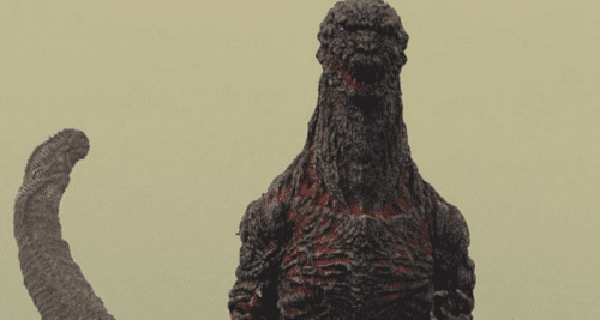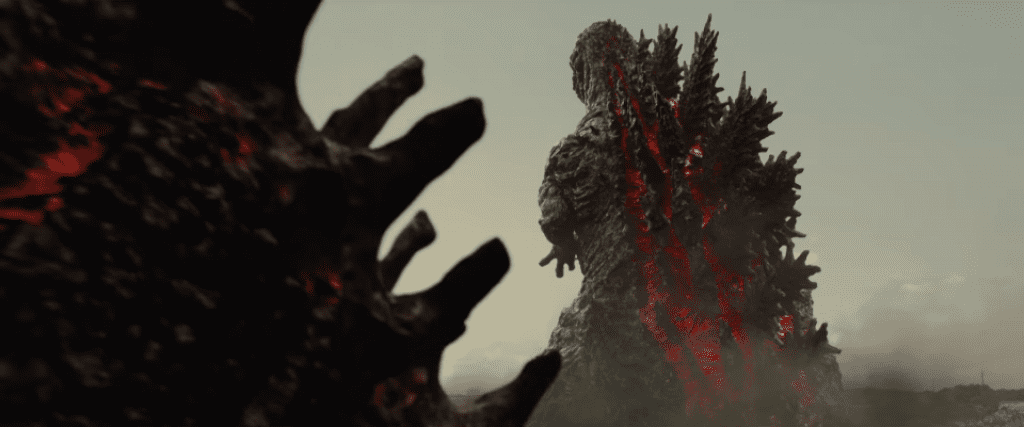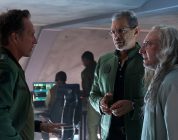The King of the Monsters is reborn again, but does this new interpretation live up to the hype?
Since his debut in 1954, Toho Studios’ Godzilla has been one of cinema’s most fascinating monster characters. In his debut, he was a tragic monster, not just a force of destruction like the atomic bombs that devastated Japan, but a victim of man’s obsession with radiation. Through the 60’s and 70’s, he underwent an evolution, going from an aggressive monster fighting with other creatures and humanity to the planet’s foremost defender. When rebooted in the 80’s-90’s series, he became an angry creature that wanted to be left alone, fighting when provoked. In the 2000’s, the films were less connected to each other, allowing for various interpretations to occur from over-the-top action monster to supernatural menace. Even in 2014’s American film, Godzilla was reimagined into a lone warrior, the last of his kind fighting threats to the balance of nature on Earth. And now, Hideaki Anno, creator of the anime hit Neon Genesis Evangelion, brings his vision to the iconic beast as screenwriter and co-director alongside Shinji Higuchi (director of Attack on Titan).
The film serves as a total reboot, the first Japanese film to not keep the 1954 film in continuity. As such, for this film’s universe, it’s the first time they’ve ever encountered a giant monster. A strange incident begins our story as we see strange activity in Tokyo Bay, with the water boiling and the Tokyo Aqua-Line flooding and collapsing (in one of the first moments for a Godzilla film to actually make me gasp in shock and fear). The Japanese government scrambles to figure out what’s going on, only for a massive creature to emerge from the water. The monster, initially resembling a grotesque eel-like creature with rudimentary legs and lungs, continues to evolve and change over the course of the film until it resembles the Godzilla we all know, except far more monstrous than we’ve seen before. And as the beast rampages through Tokyo, the various politicians, scientists and bureaucrats attempt to find a solution before the governments of the world attempt the unthinkable in order to stop Godzilla.

The film definitely has Anno’s fingerprints all over. Music is sparse, saved only for the moments when it matters most, and scenes are shot often with a very fly-on-the-wall feel, creating a constant uncomfortable feeling, less like a found-footage movie and more like you’re just a witness to the events as they happen. There’s also a lot of the deconstruction Anno famously brought to the giant robot genre in Evangelion, with the film exploring just how the government and people would react to a sudden appearance of an apocalyptic monster in their lives. Characters, places and events are introduced with flashes of onscreen text, and there are constant moments with the film shows a single, soundless image for a second before cutting to another part. It all gives the movie a sense of both fantasy realism and dread, as the kaiju genre gets played with very little humor and optimism.
Adding to the tension are the human scenes, as we see government officials realistically trying to figure out how to deal with the monster in ways that doesn’t violate its own anti-army policies. These give the film a political-thriller style of drama, as Japan finds itself backed into a corner in regards to its allies while trying to determine the best course of action. If you wanted a politically-charged Godzilla film that was even more so than 1984’s Return of Godzilla, you’re in luck.
You may have noticed that outside of Godzilla, I’ve not mentioned any other characters. That’s due in part to the political nature of the film. Most characters in this are less “characters” than they are occupations with lines. They only speak in regards to their roles in the operations to deal with Godzilla, and very few actually get any development at all. Granted, they’re all giving great performances, but they feel like just parts of a character, that character being the Japanese government. The ones who get more screen time and development, like Hiroki Hasegawa as Deputy Chief Cabinet Secretary Yaguchi, who is the main human character leading up the operations to investigate and counter Godzilla, and Satomi Ishihara as Kayoko Ann Patterson, a Special Envoy for the President of the United States with aspirations on becoming leader of America, do manage to give their characters some decent moments and insight into their own motivations, but they don’t get more than the minimum to justify them as main characters.

Then there’s Godzilla himself. I do love the new design, and hope they reuse the ideas shown here for future films where the big guy is the antagonist. I love that he’s a mix of practical effects, costumes and motion-capture CGI. I don’t even mind the initial forms he assumes throughout the film, which give a disturbing level of uncomfortable horror at what he is. But this may be the most emotionally flat interpretation of Godzilla I’ve ever seen. I started this review listing off the different “characters” Godzilla has been portrayed as for a reason. This Godzilla, outside of the destruction he causes, didn’t get much of an emotional response out of me. Compared to 1954’s film, where he’s a creature harmed by radiation lashing out at humanity as both victim and villain, or 1984’s who was a new creature exploring its surroundings only to be attacked by humans and then retaliated with rage, the new Godzilla simply comes into being and rampages because it’s what he’s supposed to do. In focusing so much on the deconstruction on how he affects the world, the monster loses out on making a real impression outside of his appearance and the destruction he causes.
Now, don’t get me wrong, this is still a good film. It’s a genuinely unique monster/disaster film that gives both insight and criticism on Japanese politics, and there are a lot of tense and scary moments. It’s definitely going to be remembered as a great film for Toho, Anno, and the genre in general. But as a Godzilla film, with only Godzilla to carry the monster side of it, and with possibly even less on-screen appearances of the big guy than 2014’s American interpretation, Shin Godzilla may disappoint franchise fans who are used to more action-packed entries. But that’s the fun thing about Godzilla movies; each one is unique and all entries have their fans. So give this one a shot, it may surprise you.
Disclosure: A press screener of the movie was provided ahead of the theater release from FUNimation Entertainment





